
Fall Festival at Mud Lake (part 1)
September 6th, 2016
After a summer spent photographing insects in the wilds of Marlborough Forest, it's back to birds, and back to the most well-known nature lovers' haunt in Ottawa: Mud Lake.

Black-and-White Warbler
Jon Ruddy sent notice on the 21st of August that a deluge was coming the next morning. A cold front was coming through, encouraging countless songbirds to get a move on southward. He was right. I arrived the next morning to find the trees off Cassels Road positively dripping with birds (though alas, much less so after a young Sharp-Shinned Hawk flew by. They were still around, of course, but all took cover in dense undergrowth.) That was a binoculars day. I came back two days later armed with my camera, and happily, found that the migrant activity was still excellent.

1680x1050 wallpaper
Of course some of the locals wanted their pictures taken too. This male cardinal was singing as proudly as ever despite his territory being overrun with vagrants, and despite his annual molt causing him to look a bit scraggly. Elsewhere I spotted a very young, just-fledged cardinal, probably from its parents' second brood this year.
Taking a side trail in the woods I stumbled upon a popular birdbath. It was a muddy inlet of the pond with hanging and fallen branches leaning all over--perfect for little birds to carefully make their way down to the shallow water. It reminded me of that magical spot in Costa Rica where Johan took us. I knelt there awhile, but though birds periodically materialized in the upper branches and descended partway, they were hesitant to actually bathe in front of me. Only this Black-Throated Green Warbler had the nerve.
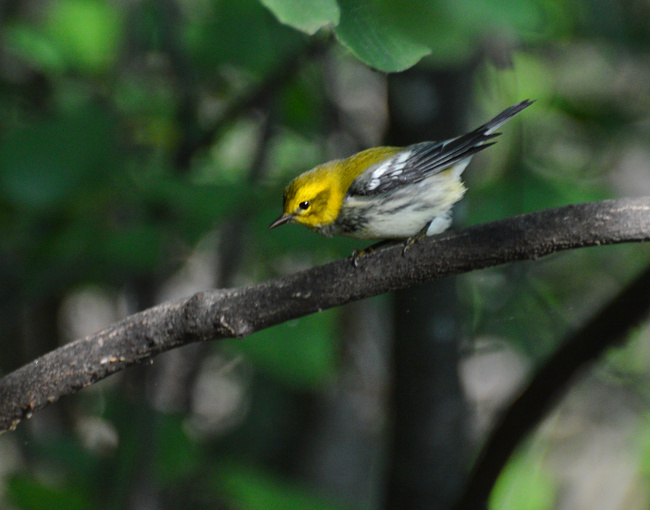
1680x1050 wallpaper

Pictured below, a Scarlet Tanager, one of the didn't-quite-dares who lingered in the trees above the bath. Only mature male Scarlet Tanagers are actually scarlet, and only in the breeding season. This one is probably a female.

1680x1050 wallpaper
A few more from Marlborough Forest
August 31st, 2016

White Admiral, wallpaper available

Daylight was waning, I was in the shade--it didn't matter. Cardinal Flowers are unconditionally blazing red! This beautiful native (pollinated exclusively by hummingbirds) was a singleton sprouting up amidst dense sprays of non-native Loosestrife and Queen Anne's Lace, literally a flower in a field of weeds (apologies to Billy Talent.)

Eastern Tailed Blue

Carpenter Ants were just boiling out of this hole in a tree. These are food source number one for Pileated Woodpeckers--comprising about 2/3 of their diet and even close to 100% in some individuals. And it's most certainly a Pileated Woodpecker who made this hole to get at them. The only question is why it moved on with so many of the colony still left!
It may have moved on because of me. Glistening rivulets of sap proved how recent the job was.

False Solomon's Seal berry is disgruntled.
Early Morning At Pink Lake
August 27th, 2016
Pink Lake is one of the most beautiful spots in the Gatineau. But it's a popular spot and sound carries around the lakeshore, so the resident wildlife tend to keep their distance from the trail. Unless you get there so early in the morning that no one else has arrived yet...

North American Beaver

Broad-Winged Hawks are phantoms of the forest--elusive deep-woods raptors. They are seldom found during the breeding season. Folks say that they're not actually rare, just shy, but if I hear their call once in a year's worth of birding, I count myself lucky. It's a call you can't mistake, a strange piercing whistle that seems more mechanical than avian. Which is how I knew who this was the moment he opened his mouth.
More thrilling still was when his call was answered by two more nearby! This youngster's whistle had a slight rasp to it; theirs were sharp and pure. A whole family group of Broad-Winged Hawks. He called back and forth with them as long as I stood there, as if seeking reassurance about the strange intruder.

1680x1050 wallpaper
A small, young-looking Northern Green Frog. I was sore for days from the position I had to contort myself into to get an unobstructed vantage on this guy. He was more well-hidden than it looks!

Common Heal-all
( More (Black-Throated Green Warbler, Purple Loosestrife, Northern Green Frog) )
Highlights from the Burnt Lands (part 2)
August 21st, 2016

Aphrodite Fritillary, wallpaper available

1680x1050 wallpaper
Delicate blue Harebells seemed to be everywhere. I've also seen this native flower at Carp Ridge, another rocky habitat (but not technically an alvar.) I find it prettier than the more common, invasive Creeping Bellflower, but maybe I'm just prejudiced in favor of the native!

There's something strange about this photo. The garter snake's reflection looks like it's eating something. The snake itself doesn't. At any rate, this guy repeatedly ducked underwater, thrashed about wildly, then emerged and tested the air as if to say, "is she gone yet?"
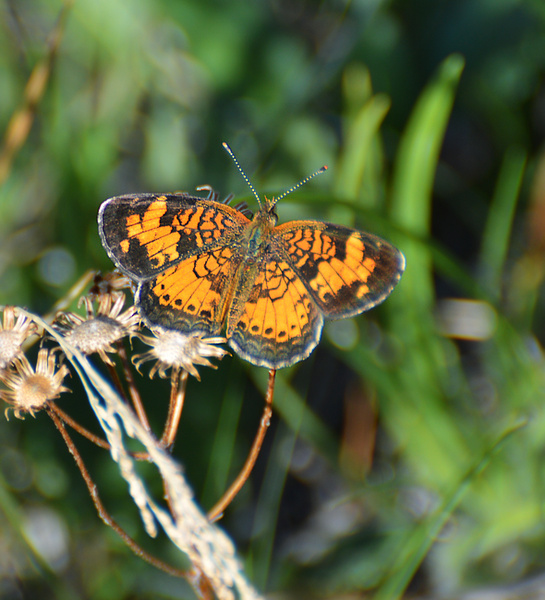
Northern Crescent
Highlights from the Burnt Lands (part 1)
August 15th, 2016
My latest new venture in nature-watching is the Burnt Lands alvar, a non-operating provincial park out in Almonte. An alvar, as I mentioned a few posts back, is a limestone plain with shallow soil. While most of eastern North America is naturally dominated by forest (the parts we haven't developed, that is), alvars create a more prairie or savannah-like ecosystem. Since this is a rare ecosystem here, rare flora and fauna are often to be found. The Burnt Lands have some startlingly rare orchids and other treasures besides. I plan to go back often this summer and fall and next spring and see what I can find.
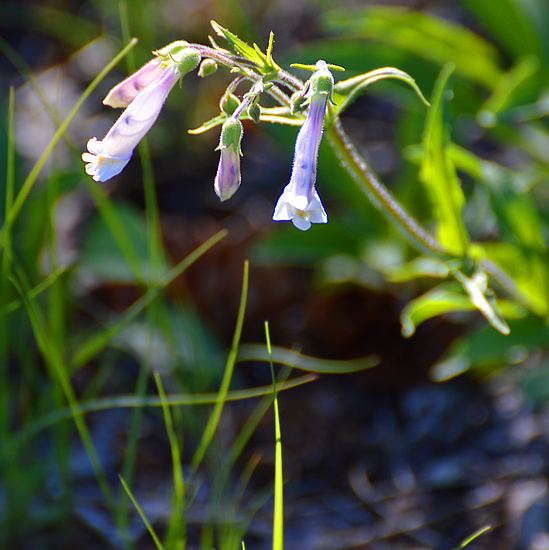
This is Hairy Beardtongue, a wildflower somewhat characteristic of alvars. I've never seen it elsewhere in Ottawa. I became excited afterwards when I learned that this flower is a larval host for Baltimore Checkerspot, a gorgeous butterfly that I have yet to see. I'm probably too late for it this year, but next June I'll be looking!

1680x1050 wallpaper
Mating Aphrodite Fritillaries. These beauties are overall rather rare in our area, but common in the Burnt Lands. The photo didn't capture it, but those pale spots on their undersides actually gleamed silver in the sunlight.

Mosaic Darner, wallpaper available
ETA: Thanks to Gillian for pointing out that this is specifically a Variable Darner ("Mosaic Darner" is a general term for dragonflies of the genus aeshna, that's all I was sure of when I posted.) That makes it a lifer dragonfly for me!

A pair of Milkweed Bugs on their favorite plant. They had just mated.

Return to Marlborough Forest (part 2)
August 9th, 2016
Because I know you didn't get enough spiders the first time.

1680x1050 wallpaper
"May. I. help. you?"
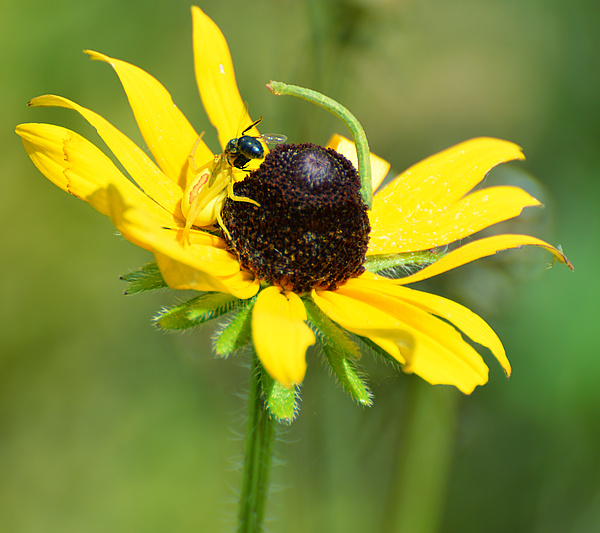
A strange trifecta. This Goldenrod Crab Spider has caught dinner (a tiny blue bee or perhaps a fly), and an inchworm is rearing up as if to spectate on the carnage!

1680x1050 wallpaper
Successful Goldenrod Crab Spider #2, this time holding what looks like a sweat bee. While I was taking photographs, a second sweat bee flew right into the spider's arms and attempted to mate with the first. Dude, seriously?

Darwin Awards: not just for people.

This strange character is called a Hunchback Bee Fly. It sneaks into wasps' nests to lays its eggs; when the larvae hatch, they eat the food that the wasps had provisioned for their larvae, and possibly the wasp larvae themselves! The adults like to nectar on black-eyed susans, which makes it no surprise at all that I saw my first in Marlborough Forest.
(A strange story to go with a strange bug: I was doing Google image searches to try to identify this and another insect (the little blue guy from three posts back, turned out to be a flower weevil.) I decided to start with the other and searched on "tiny blue bug proboscis." A photo of the hunchback bee fly (neither tiny, nor blue, though I admit it has one heck of a proboscis) turned up in the third page of hits. Has Google now achieved a psychic user interface?)
( Click for more )
Return to Marlborough Forest (part 1)
July 31st, 2016
I couldn't stay away. This time I spent the afternoon there, and managed to shoot some crowd-pleaser insects (i.e. butterflies) and forest miscellanea in addition to the usual creepy crawlies.

Silver-Bordered Fritillary, wallpaper available

This Ovenbird got ruffled, literally and figuratively, when I hiked through its territory, giving me a rare good view as it hopped out into the open to investigate the disturbance. Ovenbirds are elusive deep-woods warblers. They are actually common, but you hear their loud, rhythmic crescendo of a song far more often than you see them. They frequently erect the orange stripe on their crown when startled.

Strange berries on the forest floor. This is False Solomon's Seal, I think.
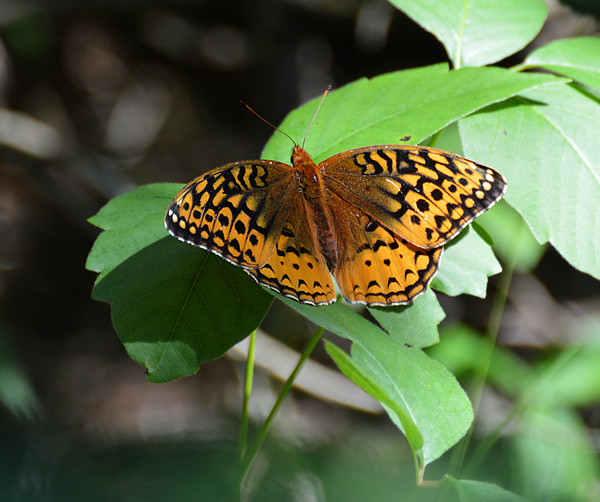
Great Spangled Fritillary, wallpaper available

Acadian Hairstreak. I almost overlooked this beauty; it appeared very small and plain until I trained the zoom lens on it. Thanks to Gillian Mastromatteo for the ID help!
Two Beauties
July 25th, 2016
A couple from Carp Ridge.

1680x1050 wallpaper
A Sweat Bee at Spreading Dogbane. Sweat bees (so named because they occasionally land on people to drink sweat) are not as well known as their larger relatives, honeybees and bumblebees, but they are important pollinators.

Common Yellowthroats nest in wet areas with dense undergrowth. They are skulky by nature, but the skulkiness is in a tug-of-war with curiosity. When a large mammal bumbles into their territory, they sometimes can't resist popping out into the open for a moment to have a look at you. It's then only a matter of firing the shutter fast enough! This one was at the edge of one of Carp Ridge's many beaver ponds.
Insect Safari At Cedar Grove
July 21st, 2016
Oh, Marlborough Forest. You are a pestilential place, but I love you.
On the evening of the 13th I went to Cedar Grove Nature Trail in North Gower, a sunset walk with camera in hand. I knew I was in the right place when eager deer flies swarmed my car. The first one bit me within 30 seconds of emerging, at which point I slathered myself with a thick layer of DEET like I should have done in the first place. I could hear them constantly buzzing around me everywhere I went, with the occasional louder zoom as a dragonfly whizzed by and picked one of them off.
There were a few more deer fly bites over the course of the evening. But that's nothing compared to what got my legs. I still don't know what it was, maybe wasps. Shortly after I stepped into a tall wildflower field something went up both pants legs and went to town on me. It didn't really hurt at the time, I assumed it was more deer flies. But by the next morning, I was swollen from my ankles almost to my knees and it hurt to stand.
For this somewhat steep entrance fee, I enjoyed the most gloriously insect-rich woodland in all of Ottawa/Gatineau. I don't know what it is about Marlborough Forest. I mean, there are insects you see everywhere. Everywhere has butterflies, everywhere has dragonflies, everywhere has mosquitos. This is not that. This is tiny weird red wasps, tiny weird blue wasps, micro moths, goldenrod crab spiders, mystery crab spiders, mystery bees, insects I don't even know how to categorize, and all of these in such numbers that it's as if the place is bursting at the seams with them. Often they crowd two or three to one flower. Maybe it's just the sheer size of the conservation area that allows it to be so rich and wild. Maybe it's the relative remoteness from urban development. I imagine that this is what the world must have been like before humans--before we razed the wilderness and sprayed insecticides all over it. This is what paradise must look like.
...well, except for the deer flies. And the wasps. And the fact that a significant fraction of those insects are looking to eat and/or parasitize the remainder. This is what paradise must look like to an entomologist, I mean.
Most of them, certainly the ones that fascinated me, were tiny insects. They made me ache for a good macro lens. I struggled to get these little beauties in focus and all of them required extensive digital sharpening. For whatever reason, just like the last time I shot insects at Cedar Grove, they were almost all on Black-Eyed Susans. They hunted atop Black-Eyed Susans, laid eggs on Black-Eyed Susans, munched on Black-Eyed Susans...

Small green inchworm-type caterpillars seemed to be everywhere I looked. Practically every other Black-Eyed Susan blossom had one on it. They were often sprawled at strange angles so as to look more like a fallen bit of plant litter than a creature, which likely helped fool predators. But I'm sure some of the predators noticed, as I did, that the little green sticks were awfully hungry.

A Goldenrod Crab Spider. I find them strangely beautiful. I seldom spot them anywhere else, but at Cedar Grove Nature Trail, it's impossible to get away from them. They perch on flowers and wait for prey to stumble by, with their four front legs spread wide poised to grab.


Eensy-weensy baby crab spider. That's a grasshopper behind it on the same flower. Regrettably, it was impossible to get both in focus.

1680x1050 wallpaper
This spindly red thing is a parasitoid ichneumon wasp, and it may have designs on that caterpillar.
Even an expert entomologist probably could not tell me which ichneumon wasp. There are thousands of known species in North America and probably thousands more undescribed. (This fact makes me want to go back to university, study entomology and do my thesis at Cedar Grove trail. Except then someone else would have to do a thesis on me, entitled "How A Woman Was Literally Driven Insane By Deer Flies.") If you are an insect and there are a lot of your kind, nature has probably evolved a parasitoid wasp just for you--that is, a wasp who will give you to its young as food. Some, like the aptly named Tarantula Hawk, paralyze their victim, drag it into a nest burrow, and lay their eggs on it. Others pierce it with a stinger-like ovipositor and lay their eggs inside, in which case it doesn't notice a thing until the eggs hatch, and the larvae start eating it from the inside out.
Many thanks to the folks at What's That Bug for their help with this one!
( Click for more )
Sweet Pea
July 17th, 2016

|
